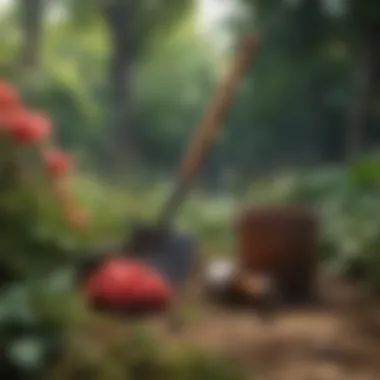Effective Treatments for Rose Fungus Explained


Intro
Rose fungus presents a considerable challenge for gardeners who take pride in their rose bushes. Understanding the various types of rose fungus and the impact they have on plant health is crucial. This guide seeks to explore effective treatment options and preventative strategies that can empower gardeners to combat these issues.
Healthy roses are a hallmark of many gardens, but fungal diseases can ruin this dream. Early detection of rose fungus is vital; it allows for appropriate measures to be taken before significant damage occurs. By diving into the subject matter, readers will obtain essential insights into both chemical and organic treatments, alongside an emphasis on sustainable gardening practices.
Knowledge about rose fungus not only helps in preserving the beauty of roses but also promotes an appreciation for responsible gardening methodologies. An informed gardener can make choices that lead to vibrant plant life while mitigating the adverse effects of fungus.
In the sections that follows, we will thoroughly analyze the types of rose fungus, discuss recognized treatment methods, and highlight important prevention tips to assist rose enthusiasts in their horticultural endeavors.
Understanding Rose Fungus
Understanding rose fungus is crucial for any gardener looking to maintain the health and vitality of their rose plants. This section lays the groundwork for identifying, treating, and preventing the common fungal infections that plague roses. By grasping the complexities of rose fungus, one can take proactive measures against these problems, optimizing care strategies and ensuring robust growth. Clear recognition of various fungal types, their symptoms, and effective treatment options empowers gardeners, allowing them to combat these aggressors efficiently.
Defining Rose Fungus
Rose fungus refers to a range of fungal infections that specifically affect rose plants. These infections can lead to various health problems, decreasing the aesthetic appeal and overall vigor of the plants. Fungi reproduce through spores, which can spread rapidly in the right conditions, leading to significant outbreaks. Understanding the definitions and mechanisms behind these fungi is essential for implementing effective treatment plans.
Common Types of Fungus Affecting Roses
Fungal diseases present unique challenges. Knowing the common types helps in early detection and treatment.
Powdery Mildew
Powdery mildew is characterized by a white or grayish powdery appearance on leaves and stems. It thrives in warm, dry conditions while the plants are stressed. Its presence significantly weakens the plant, hinders photosynthesis, and affects flowering. The easy visibility of this fungus makes it a clear indicator for gardeners. However, if left untreated, it can severely impact rose health.
Black Spot
Black spot is another pervasive issue for rose growers. It manifests as dark, circular spots on leaves, often leading to yellowing and eventual leaf drop. This fungus thrives during wet conditions, making proper air circulation and moisture control essential. Its prominent way of spreading can also render rose plants unsightly. The rapid spread of black spot requires prompt and decisive actions to avoid severe infestations.
Downy Mildew
Downy mildew is often confused with other fungal diseases. It appears as yellowish patches, predominantly on the tops of leaves, with a grayish downy growth on the underside. Typically favored by humid climates, it can be more challenging to combat once established. It strips nutrients from the plant and can stunt growth dramatically. Awareness of this condition is vital for all rose caretakers.
Rust
Rust is marked by small, orange or reddish pustules on the undersides of leaves. It can lead to premature leaf drop and ultimately hinder flowering. Rust fungi thrive in warm and humid weather conditions, taking advantage of stressed plants. Understanding its life cycle helps in devising effective management tactics, including cultural controls.
Symptoms and Signs
Recognizing early symptoms can make a significant difference in combating rose fungus. Many signs may seem trivial at first, but prompt attention is essential.
Leaf Discoloration
Leaf discoloration is often the most noticeable first sign of rose fungus. Leaves may turn yellow or exhibit spots, which indicate the plant's declining health. This symptom helps in immediate identification of the underlying problems and prevents further disease spread.
Wilting


Wilting is another major indicator that signals stress in rose plants. Affected plants cannot properly absorb water or nutrients, leading to drooping. It could stem from root issues, including those caused by fungal infections, which may obstruct nutrient flow.
Premature Leaf Drop
Premature leaf drop is a critical sign that should not be ignored. Healthy plants shed leaves gradually, but when leaf wilting and dropping happen excessively, it likely points to a significant fungal attack. Tackling this issue early on can help salvage the plant before more extensive treatment is needed.
Stunted Growth
Stunted growth is a broad term indicating that a rose plant does not reach its expected height or flowering potential. This can result from root health issues and is often exacerbated by fungal infections. Gardeners should monitor growth patterns closely to identify any divergence from normal growth habits.
The Importance of Early Detection
Rose fungus can be a serious problem for gardeners, impacting the beauty and health of the plants they cherish. Early detection is crucial when it comes to managing this type of threat. Identifying issues as soon as they arise can prevent the spread of infection and avoid more extensive damage to the roses. When a fungus takes hold, it can quickly become a tenant in the garden, and its effects may escalate if left untreated.
Addressing rose fungus at the first sign allows gardeners to implement treatment strategies before the problem worsens. This proactive approach will not only maintain the aesthetic value of the roses but also encourage overall plant vigor. A well-monitored garden may lead to robust and blooming plants that require less effort and fewer resources in the long term.
"A stitch in time saves nine." This adage rings true in gardening, particularly for those vested in cultivating roses.
The cost of delayed detection and treatment can extend beyond financial implications—it can also diminish the enjoyment of gardening.
Consequences of Delayed Treatment
Neglecting to detect rose fungus early can lead to a series of negative outcomes.
- Widespread Damage: As the fungus spreads, it can corrode a significant portion of the plant. This not only affects individual roses but can also compromise nearby plants.
- Increased Treatment Difficulty: A more established fungus is harder to eradicate. It often requires more potent treatments that may affect surrounding flora.
- Reduction in Plant Health: Prolonged fungal infection impacts nutrient uptake, leading to weaker plants that are more susceptible to other diseases and pests.
- Higher Costs and Labor: Addressing a widespread issue can escalate expenses and labor. The initial investment in early treatment often proves much less than the costs incurred from extensive damage.
The impacts of delayed treatment can be severe. The earlier a gardener responds, the better their chances of preserving the plants.
Regular Monitoring Practices
Regular monitoring is essential for any gardener aiming to maintain healthy rose plants. This commitment to ongoing inspection will serve as an early warning system for potential fungal problems. Here are some effective practices for ensuring the well-being of roses:
- Observational Walkthroughs: Engage in routine walks around the garden to visually inspect the roses' foliage and blooms. Look for any signs of discoloration or unusual spots.
- Scheduled Check-ins: Establish a timetable for checking the roses. Weekly or bi-weekly inspections can foster early detection of evolving issues.
- Note Changes: Keep a garden log. Document anything unusual about the roses. This habit can highlight trends and patterns that may indicate fungal growth.
- Engagement with Experts: Connecting with local gardening communities, whether online or offline, can provide a wealth of knowledge and anecdotal evidence regarding common diseases and their visual cues.
Chemical Treatments for Rose Fungus
Chemical treatments play an essential role in managing rose fungus. Fungicides are specifically designed to combat fungal diseases, ensuring the health of rose plants. Understanding these treatments empowers gardeners to take appropriate action against infestations that can quickly decimate their prized roses. Chemical treatments provide benefits such as rapid results and targeted action against specific types of fungus. However, these treatments also require careful consideration due to potential environmental impacts and the need for proper application techniques.
Overview of Fungicides
Fungicides are substances that kill or inhibit the growth of fungi. There are two main categories of fungicides: systemic and contact. Systemic fungicides are absorbed by the plant and spread internally, offering protection from within. Contact fungicides, on the other hand, remain on the plant's surface and act against fungus upon direct contact. Each type serves a unique function, and understanding these differences is vital for effective treatment planning.
Recommended Chemical Products
Systemic Fungicides
Systemic fungicides are vital in treating rose fungus due to their ability to protect the entire plant from within. One key characteristic of systemic fungicides is their uptake into the vascular system of the plant. This feature allows them to provide longer-lasting protection compared to many contact options. A commonly used systemic fungicide for roses is Propiconazole. It is favored because it not only prevents the spread of existing fungal spores but also protects against future infections. The advantage of systemic fungicides is their thorough internal action, though a downside is that they may take some time to show visible results.
Contact Fungicides


Contact fungicides serve as a first line of defense against fungal attacks. These are applied directly to the rose foliage and act immediately by killing fungal spores on contact. A popular contact fungicide includes Chlorothalonil. This product is beneficial because of its quick action and can be easily applied. However, one limitation of contact fungicides is that they require frequent reapplication due to environmental factors like rain or wind washing away the active ingredients.
Application Techniques
Proper application techniques are crucial for the effectiveness of chemical treatments. Here are some key practices to consider:
- Timing: Apply fungicides early in the morning or late in the evening to minimize evaporation and maximize absorption.
- Preparation: Ensure to read and follow manufacturer instructions meticulously. This includes mixing ratios and safety guidelines.
- Even Coverage: Use a pump sprayer for even coverage across all foliage. This ensures the fungicide reaches both the upper and undersides of the leaves.
- Weather Conditions: Avoid applying fungicides before rain or during windy conditions to reduce degradation of the product.
Effective use of chemical treatments can significantly reduce the presence of rose fungus and secure healthier roses for the future.
Organic Solutions for Rose Fungus
In the pursuit of maintaining healthy roses, organic solutions offer a favorable alternative to chemical treatments. They provide effective means to combat rose fungus while minimizing negative impacts on the environment. These treatments are usually derived from natural sources, making them safe for both plants and surrounding ecosystems. Organic solutions not only helps in mitigating the effects of fungal infections but also promotes sustainable gardening practices.
Natural Fungicides
Natural fungicides serve as the first line of defense against rose fungus. They typically contain ingredients from nature, offering a gentler, yet still effective approach to treatment.
Baking Soda
Baking soda stands out for its accessibility and effectiveness. It works by altering the pH levels on the leaf surface, creating an environment unattractive to fungus. Baking soda's key characteristic lies in its ability to reduce powdery mildew when used in a spray solution. This method is advantageous since it is less toxic than many commercial fungicides. However, too much baking soda can lead to plant stress, necessitating careful application.
Neem Oil
Neem oil is another effective natural fungicide. Extracted from the seeds of the neem tree, this oil has remarkable antifungal properties. Its capacity to disrupt the fungal life cycle makes it a beneficial option in the treatment of various rose diseases. Notably, neem oil is also an insect repellent, providing dual protection for your roses. While neem oil is generally safe, it can be harmful to beneficial insects if not applied carefully, so timing is crucial.
Essential Oils
Essential oils, such as tea tree or lavender oil, have garnered attention for their antifungal qualities. These oils are concentrated plant extracts that can help deter fungal growth effectively. A notable characteristic of essential oils is their pleasant aroma, making them appealing for a garden environment. However, these oils are potent and can cause phytotoxicity if not diluted properly prior to application.
Homemade Remedies
Homemade remedies represent another facet of organic solutions. They are often easy to prepare and use items typically found at home.
Garlic Spray
Garlic spray acts as a deterrent against many pathogens, including fungi. The strong odor of garlic is not only unappealing to pests but also helps ward off fungus. When mixed with water and applied to the infected areas, garlic spray can significantly reduce fungal presence. Its major highlight is the availability of garlic in most kitchens, making it a versatile treatment. However, the strong scent may linger, potentially being bothersome to some gardeners.
Milk Solution
A milk solution is another economical approach to treating fungus. The proteins in milk can help inhibit fungal growth. A typical mixture involves diluting milk with water and spraying it onto the affected plants. This solution's advantage lies in its simplicity and effectiveness against certain types of fungus. However, it is vital to use fresh milk, as spoiled milk can attract unwanted pests.
Eco-friendly Practices
Embracing eco-friendly practices ensures your rose garden remains vibrant and healthy. These practices include appropriate watering techniques, natural fertilization, and selecting plants that thrive without excessive chemical intervention. These strategies not only protect roses from fungal threats but also contribute to overall ecological health, leading to a more sustainable gardening approach.
Cultural Controls
Cultural controls are essential strategies in managing rose fungus effectively. These methods focus on developing ideal growing conditions and practices to promote plant health. Implementing these controls reduces the likelihood of fungus outbreaks and enhances the overall vigor of roses. It is important to combine these practices with other treatment methods for the best results. Cultural control techniques are typically cost-effective and environmentally friendly. They help create a sustainable approach to rose gardening, benefiting both the plants and the gardener.


Proper Watering Techniques
Watering roses correctly plays a significant role in preventing fungal diseases. Overhead watering can create the perfect environment for fungus to thrive due to prolonged leaf wetness. Instead, it is advisable to use drip irrigation or water at soil level. This method directs moisture to the roots without wetting the leaves. The best time to water is early in the morning. This timing allows the foliage to dry out during the day, discouraging the growth of mold and mildew. Ensure to check the soil moisture regularly. Deep, less frequent watering encourages healthy root development and resilience against diseases.
Fertilization Practices
Nutrient management is vital in promoting the health of roses. A balanced fertilization regimen strengthens plants, making them less susceptible to fungal diseases. Use slow-release fertilizers that are rich in potassium, phosphorus, and nitrogen. Potassium helps in building strong cell walls, which improve disease resistance. Regularly test the soil to understand its nutrient profile. This will allow for targeted fertilization without excessive use, which can lead to increased vulnerability to diseases, including fungal infections. Avoid fertilizing roses in late summer or fall as this can promote lush growth that may not have time to harden before winter.
Pruning and Air Circulation
Pruning plays a critical role in maintaining the health of rose plants. Removing dead or diseased branches improves airflow among the plants. Good air circulation minimizes humidity levels around the leaves, reducing the risks of fungal infections. Prune during the growing season to encourage strong growth and remove any visible signs of disease promptly. Properly spacing plants allows for enhanced airflow and sunlight penetration, further reducing the possibility of fungal development. Prune to shape the plant, maintain its structure, and promote a more robust growth habit.
Proper cultural controls create a foundation for healthier roses and a stronger resistance to diseases such as fungus.
By integrating proper watering techniques, sound fertilization practices, and thoughtful pruning, gardeners can effectively contribute to the health of their rose plants. Each of these elements plays a role that, when combined, enhances the roses’ resilience against fungus while promoting overall garden vitality.
Preventative Measures
Preventative measures play a crucial role in managing rose fungus effectively. The old saying, "an ounce of prevention is worth a pound of cure," holds truth in the realm of gardening. By implementing specific strategies, gardeners can significantly reduce the likelihood of fungal infections, ensuring the health and vitality of their rose plants. Careful planning and attention to details are key to maintaining robust plants that are less susceptible to disease.
Choosing Resistant Varieties
Selecting resistant varieties of roses is one of the most proactive steps a gardener can take. Many rose cultivars are bred specifically for their disease resistance. This means they exhibit greater tolerance to various fungal diseases. For example, varieties like "Knock Out" roses and "Dr. Huey" show resilience against common issues like black spot and powdery mildew.
When choosing a variety, look for labels that mention disease resistance. Researching and reviewing the characteristics of specific types can guide gardeners in making informed decisions. Local gardening centers and extension services often provide insights into which varieties thrive in specific climates, further ensuring success without added chemical treatments.
Seasonal Care Routine
A well-defined seasonal care routine contributes to the long-term health of rose plants. Each season presents unique challenges and opportunities for maintaining plant health. Regular practices help prevent the buildup of fungal pathogens.
- Spring: Start the season by inspecting plants for any signs of disease. Proper pruning, removing dead or diseased wood, and ensuring good air circulation among the branches can prevent issues. Apply mulch to retain moisture and deter weeds, which can harbor disease.
- Summer: Monitor watering practices closely. Watering in the early morning helps avoid stagnant moisture on leaves, a leading cause of fungal growth. Additionally, consider applying organic fertilizers to promote healthy growth while minimizing stress on plants.
- Autumn: As the growing season winds down, thorough cleanup is essential. Remove fallen leaves and debris that can harbor pests and fungal spores. This practice helps break the cycle of re-infection next year.
"Prevention through careful monitoring and seasonal care can save gardeners time and resources in the long run."
Establishing clear seasonal care practices not only supports plant health but also cultivates a deeper connection between the gardener and their roses. The commitment to regular care reflects in the aesthetics and vitality of the garden, enhancing the overall gardening experience.
Epilogue and Future Directions
Understanding the treatment of rose fungus is crucial for maintaining the vitality of rose plants. As highlighted throughout this article, effective management encompasses both immediate responses and long-term strategies. Successful treatment hinges on early detection, comprehensive treatment methods, and the adoption of preventative practices.
Summary of Key Treatments
In reviewing the key treatments for rose fungus, several approaches emerge as essential:
- Chemical Treatments: Fungicides can offer rapid relief from dominant fungal infections. Systemic fungicides, which absorb into the plant, provide a long-lasting defense, while contact fungicides act on the surface of the leaves. Understanding the correct usage and timing of these can greatly enhance their effectiveness.
- Organic Solutions: For those pursuing eco-friendly options, natural fungicides such as baking soda, neem oil, and essential oils serve as viable alternatives. Furthermore, homemade remedies like garlic sprays and milk solutions contribute to a holistic approach toward plant health.
- Cultural Controls: Maintaining proper watering techniques, ensuring effective air circulation through pruning, and adopting suitable fertilization practices play a vital role in minimizing the impact of fungal infections.
These integrated approaches highlight the significant interrelationship between treatment, prevention, and overall plant care.
Emerging Research and Innovations
The evolving landscape of rose fungus research presents several exciting directions. Emerging studies focus on developing resistant plant varieties through traditional breeding and biotechnological methods, reducing susceptibility to common fungi. Additionally, researchers explore innovative biological control methods, utilizing beneficial microorganisms that can suppress pathogenic fungi while being safe for the environment.
Another promising area of research is the identification of natural compounds with antifungal properties. Investigating sources like plant extracts can lead to new, effective treatments that align with organic gardening principles.
In summary, as our understanding of rose fungi improves and new innovations arise, gardeners can look forward to more effective, sustainable methods of ensuring the health of their rose plants.















